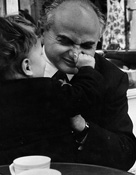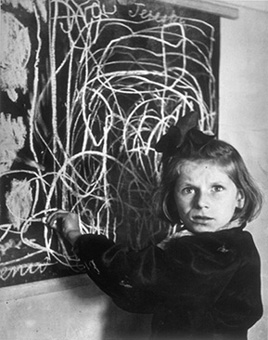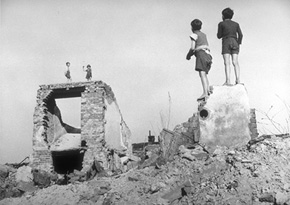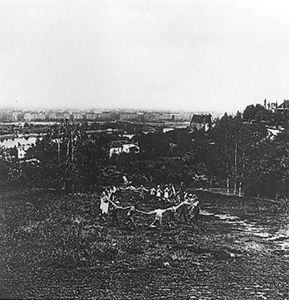
Photograh by Elliott Erwtt.
�1996 Elliott Erwitt

Tereska, a child in a residence for disturbed children, grew up in a concentration camp. She drew a picture of home on the blackboard. Poland, 1948
�1996 from the Estate of David Seymour

Boys play in bombed-out buildings in the working-class district, Favoriten, in Vienna. Austria, 1948
�1996 from the Estate of David Seymour

Villa Savoia Orphanage. Rome, 1948
�1996 from the Estate of David Seymour

Boys in the Albergo di Pobre reformatory. Naples, Italy, sp. 1948
�1996 from the Estate of David Seymour

Budapest, 1948
�1996 from the Estate of David Seymour
|
By 1948 fate dealt Chim a card that had "ace" written all over it.
UNICEF (United Nations International Children's Emergency Fund), only
recently formed, asked him to take photographs for a book depicting
Europe's children in need. It was not a lucrative proposition, but a
labor of love, for instead of paying the usual magazine rate of at
least one hundred dollars a day, all UNICEF could muster was twenty-six
dollars. The project would take twelve weeks, and Chim was to
travel to Poland, Hungary, Austria, Italy, and Greece. The purpose was
to show the work being done by UNICEF, providing some of Europe's
thirteen million children with the barest minimum of necessities:
powdered milk, a bowl of soup each day, a pair of shoes, and
vaccination against tuberculosis.
Chim's heart had always gone out to children, and they reacted
to him with complete acceptance. They seemed oblivious of him, but
he noticed every little movement, every little pain, every little
pleasure. There is no artifice, no bravura of lighting expertise in
Chim's photographs of the children. They speak simply from his
pictures, as if alive. This intellectual, so adept at analyzing the most
complex political situations, so comfortable photographing heads of
state, produced his greatest photographs to help children in need.
Some of the children were mentally disturbed, others were
maimed, many were tubercular. They were hungry. They had no
shoes. A number had prostituted themselves and had become infected
with venereal disease. The lives of these children are not a pretty
sight, but the viewer never recoils because Chim's heart was so
tender, his compassion so great, and above all, his sense of truth so
critical: he never depicted the children as hopeless. Although crippled,
Chim's children are children. The one-legged boys love to chase a ball.
The little girl whose corset supports her tubercular back gives us a
shy smile. The blind boy who lost his arms and reads Braille with his
nose desires knowledge. The girl with the tortured eyes, and the
picture of her home a huge scrawl, questions the photographer, as he
questions us.
During World War II, all over the European continent tens of
thousands of mothers and fathers were carted off to concentration
camps, or used as slave labor. Some were killed fighting for Germany.
Others, were tortured and killed fighting against it. Still others were
murdered in acts of retribution. Cities and homes disappeared in
bombing raids.
In the course of the last, desperate resistance to Allied forces,
shells turned homes into hovels. As the ruling powers fell, corruption
took over in the vacuum authoritarian power left behind. Cities
stopped functioning. Sources of water and electricity were cut and
remained in disrepair. Gasoline became a black market commodity, as
did food. Schools remained closed.
Each set of unsatisfactory social circumstances bred its own
particular brand of evil. In Vienna, occupied by the four Allies, Chim
photographed in an orphanage where fathers, Russian, French,
English, and American, never came to visit. In Rome and Naples,
children ran wild in the streets and ruins, thieving for food, pimping,
selling cigarettes made from recycled butts. Church organizations set
up day camps and orphanages. Funds were limited and conditions
were poor.
But it was not all gloom. In the poorest sections of Naples,
where there had been no bombing and fighting, family structures
were left intact. In spite of extreme poverty, families took pride in
their numerous offspring. The children played happily in the streets,
naked or not, in the heat.
For once Chim was not just telling a story, as was his usual goal
as a photo-reporter, but instead was making a statement to drive
home the universal condition of children at risk. Chim's Children, as
these photographs came to be known, is a memorial to his gentle
mother, to whom he was much attached, and to his father, who was
an ideal for him: intelligent, enterprising, and optimistic.
- Inge Bondi
� 1996, Inge Bondi
from CHIM: The Photographs of David Seymour, Bulfinch Press/Little, Brown and Company
|





































